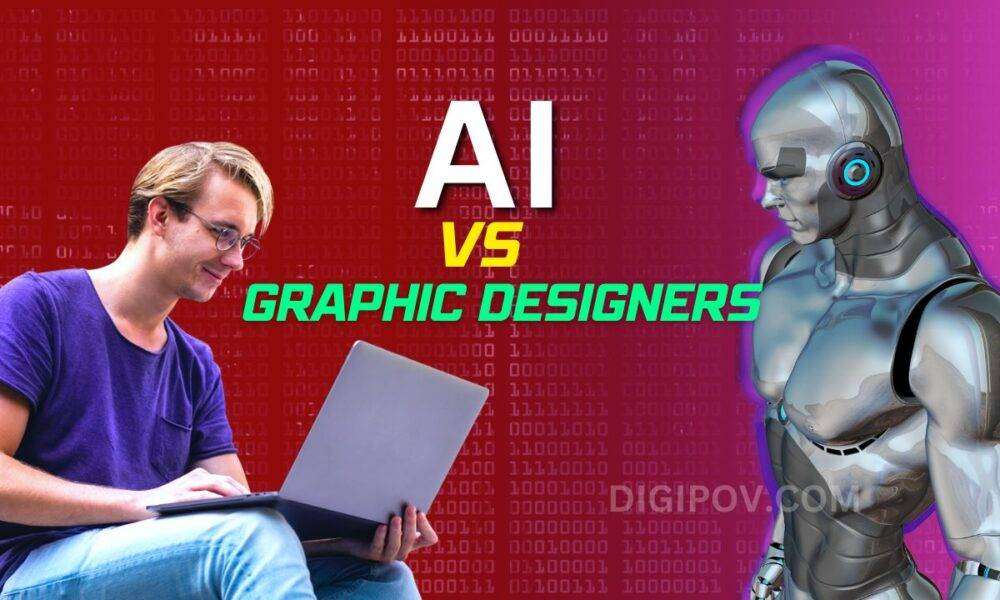
Are graphic designers being replaced by AI? The rapid advancement of artificial intelligence (AI) is transforming numerous industries, and graphic design is no exception. While AI tools are becoming increasingly sophisticated in creating visuals and automating design tasks, the question remains: are human graphic designers truly at risk of being replaced? This article dives into the potential impact of AI on graphic design, examining the evolving role of designers, the challenges and opportunities presented by automated design tools, and how designers can adapt to thrive in this changing environment.
The Rise of AI in Design:
Exploring the Potential Impacts
AI is rapidly reshaping industries, and graphic design is not immune. AI-powered tools are automating tasks traditionally handled by human designers, including generating images, creating layouts, and even performing color adjustments. This surge in AI-driven design tools has sparked debates about the future of graphic design, prompting questions about job displacement and the evolving skill sets needed for success. The creative potential of AI in generating visual elements is undeniable. Consider the numerous AI art generators available today; they can produce impressive pieces with a variety of styles and aesthetics, prompting a nuanced examination of the human role in the creative process. This evolution requires designers to re-evaluate their skill sets and adapt their practices to remain competitive in the market.
The Challenges of AI-Driven Design:
Adapting to Evolving Trends
While AI tools automate certain design tasks, they still lack the nuanced human understanding of creativity, problem-solving, and context that human designers possess. Human designers bring emotional intelligence and artistic judgment to the design process, something that AI is still struggling to replicate consistently. Furthermore, the integration of AI tools into design workflows may require a shift in skills. Designers must learn to leverage these tools effectively, shifting their focus from purely technical execution to creative conceptualization and project management. This necessitates a deeper understanding of the strengths and limitations of AI design tools. Designers who fail to adapt to this new reality may find themselves sidelined in the creative process.
The Future of Graphic Design:
Strategies for Adapting and Thriving
The future of graphic design lies not in replacing human designers but in fostering collaboration between humans and AI. Designers should embrace AI tools as powerful assistants, automating mundane tasks and freeing up time for more strategic, creative problem-solving and conceptualization. Designers can use AI tools for tasks like generating initial design concepts, producing mockups, or refining visual elements; however, they need to maintain their creative intuition for refining the designs and achieving the perfect result. The focus should shift from technical execution to conceptualization, strategy, and client communication. Successful designers of the future will be those who can effectively bridge the gap between human creativity and AI assistance.
Case Studies of AI in Design:
Illustrative Examples
Several companies are already experimenting with AI in their design processes. For example, some marketing agencies use AI-powered tools to create variations of marketing materials, testing different layouts, colors, and typography. These tools can quickly analyze trends in consumer engagement and refine design solutions based on data and real-world feedback. Moreover, designers can use AI-generated ideas as springboards to develop their own concepts, potentially leading to innovative and more effective designs.
The Importance of Continuous Learning:
Embracing the AI Revolution
To thrive in the evolving graphic design landscape, continuous learning is crucial. Designers need to stay updated on the latest AI tools and technologies. Taking online courses, attending workshops, and experimenting with new tools is vital. Learning how AI design tools operate, and what they can offer to augment a designer’s process is essential to the future of design. Further developing soft skills like communication, collaboration, and critical thinking will be essential. In addition, fostering a design philosophy that emphasizes creativity and emotional engagement with the design process will be critical to maintain competitive advantages.
Alternative Solutions for Designers:
Transitioning into a New Era
Designers should explore ways to augment their skills with tools, and be open to incorporating AI into their creative workflow, rather than seeing it as a threat.
The Impact of AI in Specific Areas of Design:
Detailed Analysis
AI is having a major impact on several facets of design, leading designers to explore new strategies for their workflow
Conclusion:
Final Thoughts
In conclusion, AI is dramatically transforming the graphic design industry, but it’s not going to eliminate the need for human creativity and problem-solving
Statistics & Data Supporting Claims:
Quantitative Data
(This section can be included with specific statistics to provide support for the claims.)
FAQ:
Answers to your questions
Q1: Can AI truly replace human graphic designers?
A1: AI tools are excellent at automating repetitive tasks and generating various design elements. However, the creative process, the ability to understand client needs, solve problems, and provide exceptional artistic output still relies on the human touch. Graphic designers who adapt to integrating AI tools into their workflow while retaining their unique creative perspectives will be best-positioned to thrive in the future.
Q2: How can graphic designers prepare for the future of work, in an age of AI-driven design?
A2: Graphic designers need to develop their creative problem-solving skills, and focus on what AI is not capable of- such as crafting unique and relevant concepts. Embracing continuous learning about new design software, techniques, and AI tools is paramount. Focus on client communication, strategy development, and project management to leverage the human element of graphic design.
In conclusion, while AI is rapidly advancing graphic design capabilities, it’s unlikely to fully replace human designers anytime soon. The creative, nuanced, and problem-solving aspects of graphic design still require a human touch. AI tools are best used as powerful assistants to enhance and accelerate design processes. To stay competitive, graphic designers should embrace these new tools, focusing on tasks where AI excels and preserving their own unique creative abilities. Keep learning new software and techniques, and embrace continuous learning in design and AI to thrive in this evolving landscape.